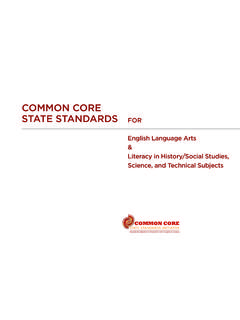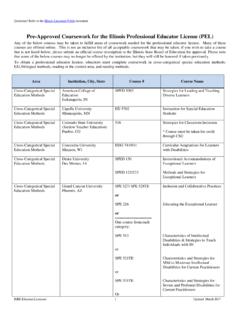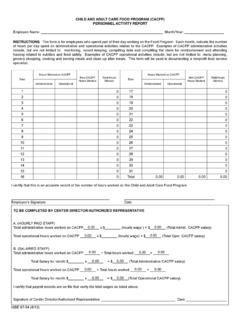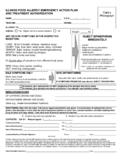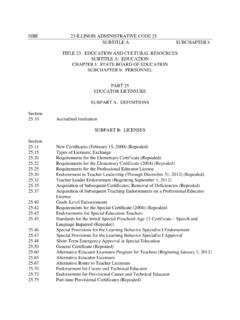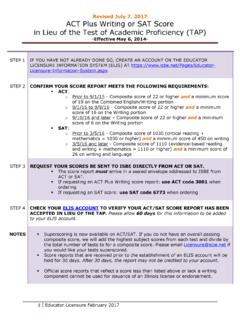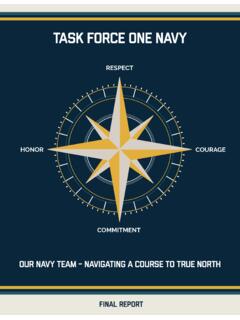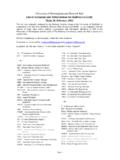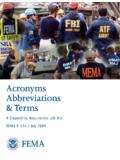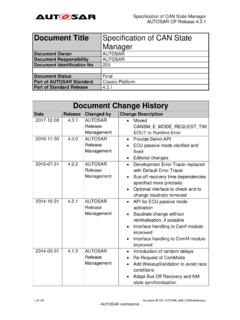Transcription of I. Naming Conventions - Illinois State Board of Education
1 SQL Server Standards Version Shane Lively & Michael Sarsany Page 1 of 24 I. Naming Conventions The main goal of adopting a Naming convention for database objects is so that you and others can easily identify the type and purpose of all objects contained in the database. The information presented here serves as a guide for you to follow when Naming your database objects. When reading these rules and guidelines, remember that consistent Naming can be the most important rule to follow. Please also keep in mind that following the guidelines as outlined in this document can still produce long and cryptic names, but will limit their numbers and impact.
2 However, ultimately your unique situation will dictate the reasonability of your Naming convention. The goal of this particular Naming convention is to produce practical, legible, concise, unambiguous and consistent names for your database objects. This section is a generic DBMS-neutral guide for Naming common objects. While most databases contain more types of objects than those discussed here (User Defined Types, Functions, Queries, etc.), the 7 types of objects mentioned here are common among all major database systems.
3 The following types of database objects are discussed here: 1. Tables 2. Columns (incl. Primary, Foreign and Composite Keys) 3. Indexes 4. Constraints 5. Views 6. Stored Procedures 7. Triggers Try to limit the name to 50 characters (shorter is better) ALL DATABASE OBJECTS Avoid using underscores even if the system allows it, except where noted in this document. PascalCase notation achieves the same word separation without them and in fewer characters. Use only letters or underscores (try to avoid numbers and limit the use of underscores to meet standards for Constraints, Special-Purpose Indexes and Triggers or unless implementing a modular Naming convention as defined in this document).
4 SQL Server Standards Version Shane Lively & Michael Sarsany Page 2 of 24 Use a letter as the first character of the name. (don't start names with underscores or numbers) Limit the use of abbreviations (can lead to misinterpretation of names) Limit the use of acronyms (some acronyms have more than one meaning "ASP") Make the name readable (they shouldn't sound funny when read aloud). Avoid using spaces in names even if the system allows it. 1. TABLES When Naming your database tables, give consideration to other steps in the development process.
5 Keep in mind you will most likely have to utilize the names you give your tables several times as part of other objects, for example, procedures, triggers or views may all contain references to the table name. You want to keep the name as simple and short as possible. Some systems enforce character limits on object names also. Rule 1a (Singular Names) - Table names should be singular, for example, "Customer" instead of "Customers". This rule is applicable because tables are patterns for storing an entity as a record they are analogous to Classes serving up class instances.
6 And if for no other reason than readability, you avoid errors due to the pluralization of English nouns in the process of database development. For instance, activity becomes activities, ox becomes oxen, person becomes people or persons, alumnus becomes alumni, while data remains data. Rule 1b (PrefixesDo not give your table names prefixes like "tb" or "TBL_" as these are redundant and wordy. It will be obvious which names are the table names in SQL statements because they will always be preceded by the FROM clause of the SELECT statement.)
7 In addition, many RDBMS administrative and/or query tools (such as SQL Server Management Studio) visually separate common database objects in the development environment. Also note that Rule 5a provides a means to distinguish views from tables. ) Don t use prefixes unless they are deemed necessary to help you organize your tables into related groups or distinguish them from other unrelated tables. Generally speaking, prefixes will cause you to have to type a lot of unnecessary characters. SQL Server Standards Version Shane Lively & Michael Sarsany Page 3 of 24 In some cases, your tables might be sharing a schema/database with other tables that are not related in any way.
8 In this case, it is sometimes a good idea to prefix your table names with some characters that group your tables together. For example, for a healthcare application you might give your tables an "Hc" prefix so that all of the tables for that application would appear in alphabetized lists together. Note that even for the prefix, use PascalCase. This is discussed in Rule 1c. Do not use underscores in your prefixes, which is discussed in more depth in Rule 1d. The last kind of prefix that is acceptable is one that allows you to group logical units of tables.
9 A plausible example could entail a large application (30 to 40+ tables) that handled both Payroll and Benefits data. You could prefix the tables dealing with payroll with a "Pay" or "Prl" prefix and give the tables dealing with benefits data a "Ben" or "Bfts" prefix. The goal of both this prefix and the aforementioned shared schema/database prefix is to allow you to group specific tables together alphabetically in lists and distinguish them from unrelated tables. Lastly, if a prefix is used for this purpose, the shared schema/database prefix is a higher grouping level and comes first in the name, for example, "HcPayClients" not "PayHcClients".
10 Rule 1c (Notation) - For all parts of the table name, including prefixes, use Pascal Case. Using this notation will distinguish your table names from SQL keywords (camelCase). For example, "select CustomerId, CustomerName from MyAppGroupTable where CustomerName = '%S'" shows the notation for the table name distinguishing it from the SQL keywords used in the query. PascalCase also reduces the need for underscores to visually separate words in names. Rule 1d (Special Characters) - For table names, underscores should not be used.

